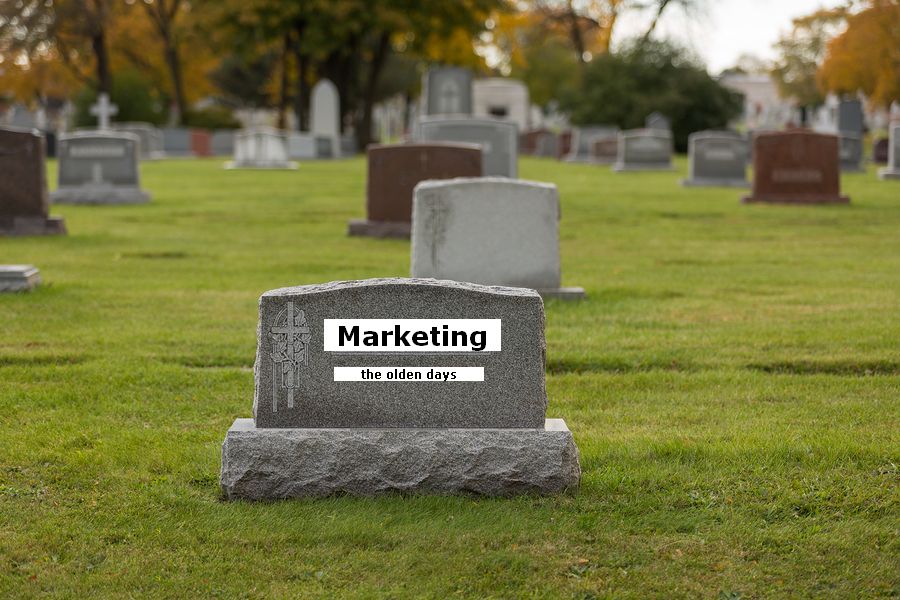
The final Sales Trend for 2013 is ”Marketing (as we know it) is dead” but you probably already know that given the rapid changes happening in our markets.
Traditional marketing, i.e. advertising, PR, branding and corporate communications, has become little more than an expensive, very often valueless mass communications methodology and has failed. Marketing has been at death’s door for well over a decade. It’s just that marketing professionals don’t want to recognise the reality!
 There are three pointers that prove this:
There are three pointers that prove this:
- Buyers are no longer paying much attention to marketing messages. Studies show that in the decision-making process, traditional marketing communications techniques have very little credibility or relevance. Buyers are checking out product and service information in their own way.
- In a devastating 2011 study of 600 CEOs and decision-makers, around 73% said that marketing officers lacked business credibility or the ability to generate sufficient business growth. Around 72% of respondents in the study indicated that they were tired of being asked for funds without being given any reassurance that the funds would generate incremental business and 77% are no longer interested in any talk about brand equity that can’t be directly linked to recognised financial metrics.
- In today’s increasingly social media-infused environment, traditional marketing techniques not only don’t work, they make no sense. Trying to extend the 4 Ps to a world of social media simply misses the mark. It finds itself mired in an ongoing debate about whether marketing on either Facebook or using Google Ads is as effective as it needs to be.
The result is a disaster for marketing. So…
- Why has marketing taken such a credibility beating?
- Why now is sales finally getting the professional recognition it really deserves?
Whilst over the decades of continually changing buying patterns and behaviours sales has made the necessary adjustments – from Snake Oil Selling in the 1890’s to the sophisticated Solution Selling of the 21st Century – marketing has continued, in the face of the increasing change, to hang on to its outdated 1948 model.
This is how sales did it:
Sales developed Solutions Selling, where a buyer is guided by professionals who understand what their company and their rivals’ offer; who understands what the buyer is trying to achieve and the risks and costs associated with both success and failure.
Just as there is new thinking around sales methodologies there is a lot of speculation about what will replace marketing’s broken model. What is certain is that the 4Ps of marketing popular in the 1970’s can’t and won’t work today. Marketing needs a shake up! A new model.
What should that model look like? In the end, marketing professionals will have to decide, but in their thinking they should be considering the following:
 A Change in the Market Segmentation: Theodore Levitt[1] used to tell his students, “People don’t want to buy a quarter-inch drill. They want a quarter-inch hole!”Every marketer agrees with this insight. Yet these same people segment their markets by type of drill and by price point. When marketers do this, they often solve the wrong problems, improving their products in ways that are irrelevant to their customers’ needs.There is a better way to think about segmentation that supports both sales and marketing – the structure of a segment, seen from the customers’ point of view with adoption of a SIVA model (Solutions, Information, Value and Access) to replace that of the 4Ps.Just take a look at what customers want. They need to get something done. Levitt (Harvard) once said that when people find themselves needing to get a job done, they essentially “hire products” to do that job. This left marketing professional with a clear mandate – understand what jobs arise in customers’ lives for which they might hire products. Package the company’s product and associated experiences and deliver them in a way that reinforces their intended use for which customers find themselves needing to get a job done. That way customers will hire the product.
A Change in the Market Segmentation: Theodore Levitt[1] used to tell his students, “People don’t want to buy a quarter-inch drill. They want a quarter-inch hole!”Every marketer agrees with this insight. Yet these same people segment their markets by type of drill and by price point. When marketers do this, they often solve the wrong problems, improving their products in ways that are irrelevant to their customers’ needs.There is a better way to think about segmentation that supports both sales and marketing – the structure of a segment, seen from the customers’ point of view with adoption of a SIVA model (Solutions, Information, Value and Access) to replace that of the 4Ps.Just take a look at what customers want. They need to get something done. Levitt (Harvard) once said that when people find themselves needing to get a job done, they essentially “hire products” to do that job. This left marketing professional with a clear mandate – understand what jobs arise in customers’ lives for which they might hire products. Package the company’s product and associated experiences and deliver them in a way that reinforces their intended use for which customers find themselves needing to get a job done. That way customers will hire the product.- Design Products that do the Job: With few exceptions, every job people need or want to do has a social, a functional and an emotional dimension. If marketing professionals understand each of these dimensions, then they can package a product that is precisely targeted to the job. In other words, the job, not the customer is the fundamental unit of analysis for marketing when it comes to packaging and promoting products.Job-defined markets (i.e. segmentation by what the product is expected to do) are generally much larger than product category – defined markets.
- Purpose Brands: Understanding and targeting jobs was one of the important building blocks in Apple’s success. Steve Jobs never believed in market research. He argued that if he asked consumers what new innovations they wanted they would use their present paradigm to describe some innovation. He wanted new thinking and therefore never sought the opinion of his customers. Instead, he and his associates spent much of their time watching what people were trying to get done in their lives, then asking themselves whether Apple’s technology could help them do these things better and easier. Jobs would have badly misjudged the size of the market had he simply analysed trends in the number of mobile phones were being sold before he launched his iPhone.
- Building Brands that Customers will Hire: Sometimes, the discovery that one needs to get a job done is conscious, rational and explicit. At other times, the job is so much a part of a routine that customers aren’t really consciously aware of it. Either way, if buyers are lucky, when they discover the job they need to do, a branded product will exist that is perfectly and unambiguously suited to do it. That’s called a purpose brand. Marketing needs to go back to these basics.
- The Real Role of Advertising: Advertising cannot build brands or sell products, but it can tell people about an existing branded product’s ability to do a job well and it can encourage people to try the brand out.
We’ve tried to illustrate a way out of the death spiral for marketing. Marketers who choose to break with the past will be rewarded not only with successful brands but with profitably growing businesses. Sales professionals who make the leap to Solutions Selling will find that they are able to sell more, more effectively at better margins. And companies that re-assess the role of selling and marketing will benefit from sustained incremental profits. Perhaps most importantly customers will get the value they are seeking at prices they are willing to pay.
Remember everybody lives by selling something.
Author: Sue Barrett, www.barrett.com.au


New Article Email Notification